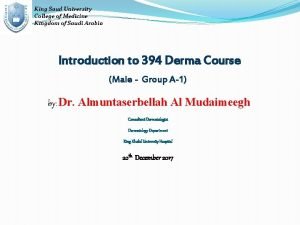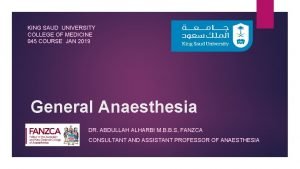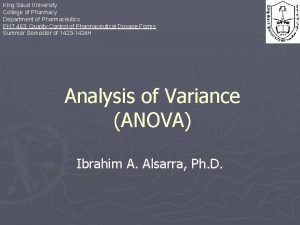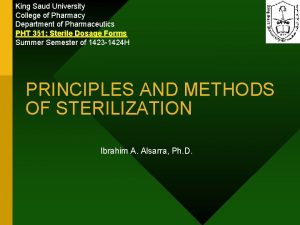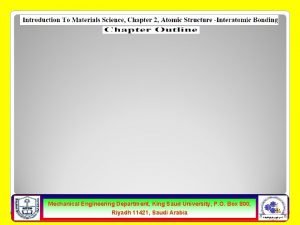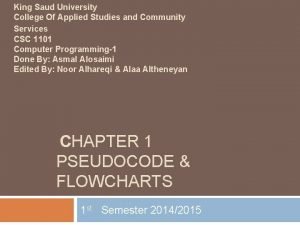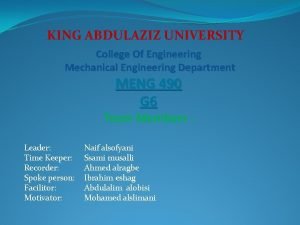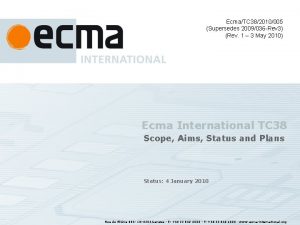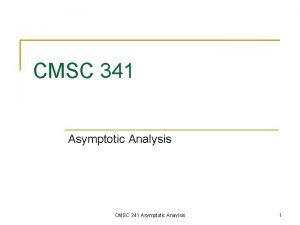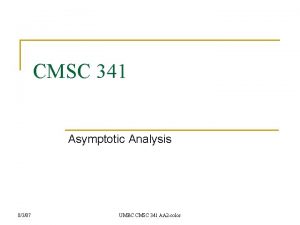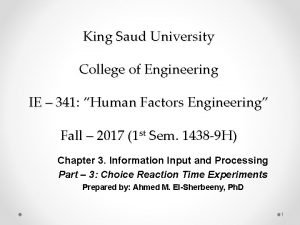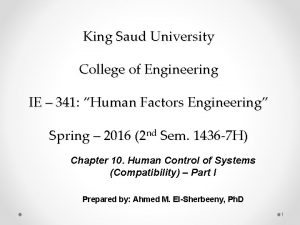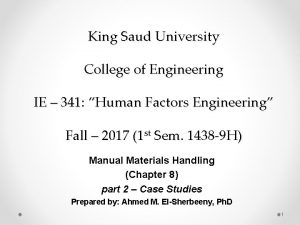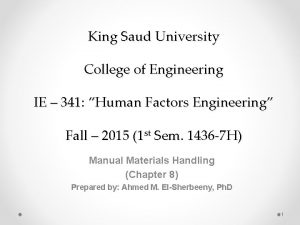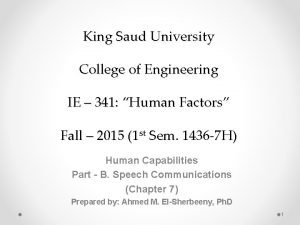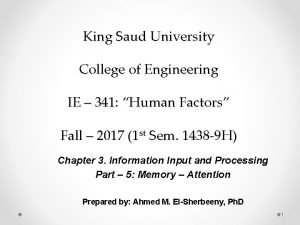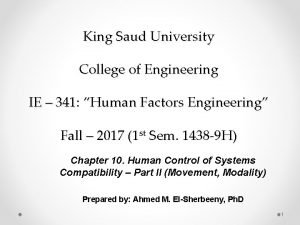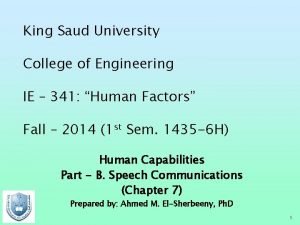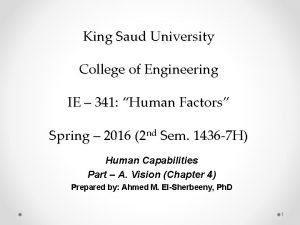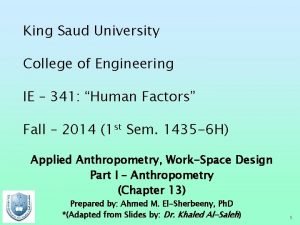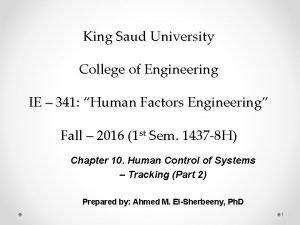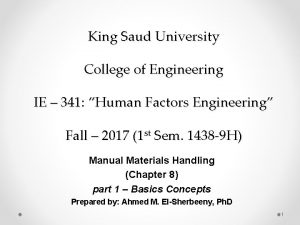King Saud University College of Engineering IE 341

















- Slides: 17

King Saud University College of Engineering IE – 341: “Human Factors” Fall – 2014 (1 st Sem. 1435 -6 H) Human Capabilities Part – I. Hearing (Chapter 6*) Prepared by: Ahmed M. El-Sherbeeny, Ph. D 1

Lesson Overview Hearing ◦ Nature and Measurement of Sounds Frequency of Sound Waves Intensity of Sound Complex Sounds ◦ Masking Auditory Displays ◦ ◦ Detection of Signals Relative Discrimination of Auditory Signals Absolute Identification of Auditory Signals Sound Localization Noise 2

Hearing Direct vs. Indirect hearing: ◦ Direct hearing: e. g. baby’s natural cry ◦ Indirect hearing: e. g. doorbell ⇒ someone at door ◦ Indirect stimulus can be more effective than direct e. g. fire alarm (100% detectable) vs. heat/smoke (75%) Nature and Measurement of Sounds ◦ Sound is created by vibrations from a source and is transmitted through a medium (such as atmosphere) to the ear ◦ Two primary attributes of sound: Frequency Intensity (or amplitude) 3

Cont. Hearing Frequency of Sound Waves : ◦ When sound is generated, vibration ⇒ air molecules to move back and forth this alternation ⇒ ↑ and ↓ in air pressure ◦ Vibration forms sinusoidal (sine) waves height of wave above and below the midline represents the amount of above-normal and below-normal air pressure respectively The waveform above the midline is the image of the waveform below the midline in a sine wave. The waveform repeats itself again and again in a sine wave frequency of sound: “number of cycles per second” expressed in: hertz (Hz) ; 1 Hz ≡ 1 cycle / 1 second 4

Cont. Hearing Cont. Frequency of Sound Waves : ◦ Sinusoidal wave created by a simple soundgenerating source 5

Cont. Hearing Cont. Frequency of Sound Waves : ◦ The human ear is sensitive to frequencies 20 to 20, 000 Hz highest sensitivity: between 1, 000 to 3, 000 Hz ◦ Ear is not equally sensitive to all frequencies ◦ People differ in their relative sensitivities to various frequencies Intensity of Sound (amplitude/loudness): ◦ defined in terms of power per unit area ◦ The Bel (B) [after Alexander Graham Bell] is the basic unit for measuring sound (log scale) ◦ The most convenient measure is: decibel (d. B) 1 d. B=0. 1 B 6

Cont. Hearing Cont. Intensity of Sound ◦ Figure 6 -2: Decibel levels for various sounds. ◦ Note ↑ 10 d. B ⇒ ↑ 100 -fold sound pressure ◦ Signal-to-Noise Ratio (SNR): difference bet. meaningful signal, & background noise e. g. 90 d. B signal, 70 d. B noise ⇒ SNR = +20 d. B 7

Cont. Hearing Complex Sounds: ◦ Very few sounds are pure ◦ Most complex sounds are non-harmonic ◦ Figure 6 -3: waveform of a complex sound formed by 3 individual sine waves 8

Cont. Hearing Masking (defined): ◦ Condition when one component of the sound environment reduces the sensitivity of the ear to another component ◦ It is amount that the “threshold of audibility” of a sound (the masked sound) is raised by the presence of another (masking) sound ◦ Q: Can you a give an example of “masked” and “masking” sounds from our everyday lives? ◦ Q: difference between masked and complex sounds? 9

Auditory Displays 1. 2. 3. 4. Chapter 3: auditory vs. visual modality (e. g. auditory preferred: message is short, simple) 4 types of human functions/tasks involved in the reception of auditory signals: Detection (i. e. whether a signal is present) Relative discrimination (differentiating bet. ≥ 2 signals presented together) Absolute identification (only 1 signal is present) Localization (knowing the direction that the signal is coming from) 10

Cont. Auditory Displays Detection of signals ◦ Signals can occur in “peaceful” surroundings or noisy surroundings ◦ The signal plus noise (SN) should be distinct from the noise (N) itself ◦ Otherwise, signal cannot always be detected in the presence of noise i. e. signal (masked sound) + noise (masking sound) ⇒ threshold of detectability is elevated ⇒ signal must be > threshold to detect signal ◦ Using filters ⇒ noise removed ⇒ ↑ detectability, SNR ⇒ more audible sound 11

Cont. Auditory Displays Relative Discrimination of Auditory Signals ◦ Relative discrimination of signals on basis of intensity frequency ◦ A common measure of discriminability: just-noticeable difference (JND): JND: “the smallest difference or change along a stimulus dimension (frequency, intensity) that can just be detected 50% of the time by people. ” The smaller the JND, the easier it is for people to detect differences on the dimension being changed. Small JND ⇒ subjects could detect small changes Large JND ⇒ large change necessary before noticing change 12

Cont. Auditory Displays Absolute Identification ◦ This is used when it is necessary to make an absolute identification of an individual stimulus (by itself) ◦ e. g. identify someone’s pitch/frequency specific animal/bird certain car siren/honk tone Sound durations ◦ Number of levels along a continuum (range or scale) that can identified usually is quiet small ◦ It is better to use more dimensions with fewer steps or levels of each dimension, than to use fewer dimensions and more levels of each 13

Cont. Auditory Displays Localization ◦ Stereophony: “the ability to localize (guess/predict) the direction from which the sound is emanating (coming from)” ◦ Primary factors/cues used to determine direction intensity of sound phase (lag) of sound e. g. if sound reaches directly one side of head first, sound reaches the nearer ear approx. 0. 8 ms before other ear ⇒ localizing sounds below 1500 Hz For frequencies > 3000 Hz, intensity is used to localize sound (e. g. try to gradually increase volume in one speaker and decrease volume in opposite speaker) Sounds between 1500 -3000 Hz: hard to localize 14

Cont. Auditory Displays Special purpose auditory displays: ◦ Warning and alarm signals Each signal having preferred frequency, intensity Each causing certain “attention-getting” and “noisepenetration” ability ◦ Aids for the blind Mobility aids (go-no-go safety signals at certain distance) Environmental sensors (information about surrounding, e. g. surface characteristics, directional information, distance) 15

Noise ≡ ◦ “Unwanted sound” ◦ Information theory: “auditory stimulus of stimuli bearing no informational relationship to the presence or completion of the immediate task” Effects of noise ◦ ◦ Hearing loss (e. g. occupational hearing loss) Temporary loss, permanent loss Physiological effects Psychological effects 16

References ◦ ◦ Human Capabilities - Hearing Human Factors in Engineering and Design. Mark S. Sanders, Ernest J. Mc. Cormick. 7 th Ed. Mc. Graw: New York, 1993. ISBN: 0 -07 -112826 -3. Slides by: Dr. Khaled Al-Saleh; online at: http: //faculty. ksu. edu. sa/alsaleh/default. aspx 17
 King faisal university college of medicine
King faisal university college of medicine King saud university college of medicine
King saud university college of medicine King saud university college of medicine
King saud university college of medicine King saud university college of pharmacy
King saud university college of pharmacy King saud university college of medicine
King saud university college of medicine King saud university college of pharmacy
King saud university college of pharmacy King saud university college of pharmacy
King saud university college of pharmacy King saud university college of business administration
King saud university college of business administration Ksu mechanical engineering
Ksu mechanical engineering King saud university riyadh
King saud university riyadh King saud university hospital nurse salary
King saud university hospital nurse salary College of engineering, king abdulaziz university
College of engineering, king abdulaziz university Oscillopsia
Oscillopsia 詹景裕
詹景裕 Sda hymn 341
Sda hymn 341 Ecma-341
Ecma-341 Cmsc 341
Cmsc 341 Cmsc 341
Cmsc 341
